Is it possible to lay brick in winter? Options for laying bricks at sub-zero temperatures.
Usually construction work are held in the warm season. Winter is considered not the best time for bricklaying and other work. But there are exceptions to any rule. For example, when a building cannot withstand preservation for the winter and may significantly collapse during this period. Before starting the construction process, you need to find out at what temperature bricks can be laid.
Brick laying problems in winter
Many people ask the question: “Why can’t you lay bricks in the cold?” Let's remember the composition of the solution and physics. So, a mixture consisting of water, sand and cement is used. It is water that plays the key role here. This is what slows down the whole process. At sub-zero temperatures, water becomes solid and turns into ice. Therefore, no hydration process occurs between the masonry and the mortar. Even if the water in the masonry does not have time to freeze, some of the bricks will be covered with ice. When the air temperature rises and the ice begins to melt, the strength of the masonry will drop by half. The water that was inside the entire structure will also melt, and the entire structure will collapse quickly. And yet at what temperature can bricks be laid? In order for the regular one to set and dry, it must be at least -5°C outside. Otherwise, in the spring the building will collapse.
How to prepare mortar for winter masonry?
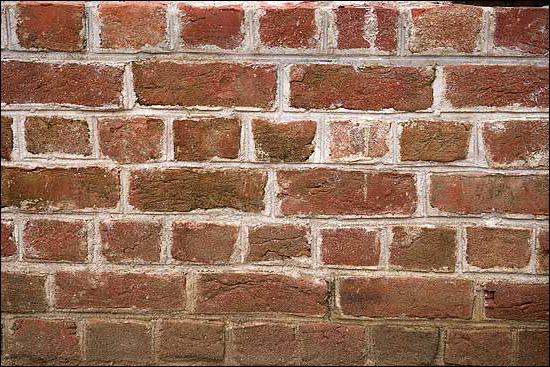
But, despite all these subtleties, a way was found to increase the temperature to which bricks can be laid. To do this, you need to use a special solution that contains With their help, it was possible to reduce the temperature limit to -50°C. This method of constructing buildings is especially popular in places where the air temperature is below zero for most of the year.
After the masonry is laid, it remains to monitor the solidification of the solution. To do this, peculiar holes with plugs are made in the masonry, inside of which the temperature is measured using a thermometer.
If it is impossible to maintain the thermal regime during hardening, special equipment is connected to heat and dry the masonry. If this happens, it may be necessary to install additional greenhouses. They are mounted above the masonry. Now for builders the question of at what temperature bricks can be laid is not so pressing.
It must be borne in mind that additives that prevent the solution from freezing are harmful to humans. Therefore, you need to lay bricks only in a special protective suit.
Several ways to lay bricks in the cold season
For high-quality work in sub-zero weather, the following technologies are used.
Electric heating This is the most labor-intensive and energy-consuming method. It is used in the construction of small sections of walls. During the laying process, electrodes are placed in the solution, through which they are passed. With its help, the seams dry out, and the formation of ice is excluded.
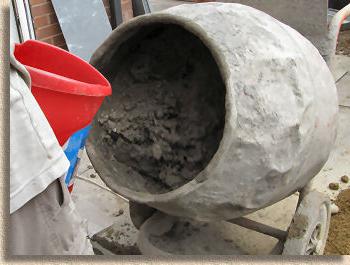 Arrangement of a hothouse. This method is highly efficient and economical, but at the same time quite labor-intensive. At the place where the wall will be driven out, a frame is installed on which plastic curtains will be stretched. A heat source is installed inside the resulting tent and construction begins. Such a greenhouse must be heated for a long time until the masonry dries.
Arrangement of a hothouse. This method is highly efficient and economical, but at the same time quite labor-intensive. At the place where the wall will be driven out, a frame is installed on which plastic curtains will be stretched. A heat source is installed inside the resulting tent and construction begins. Such a greenhouse must be heated for a long time until the masonry dries.
Freezing. Here they use a frost-resistant solution, which can set again after the onset of warm weather. During the work process, it is important to ensure that there is no frost on the consumable material. If there are any, get rid of them using an injection burner.
Final stage
Once the answer to the question of at what temperature bricks can be laid has been found, and the foundation for future walls has already been laid, we move on to the final work. After the height of the wall becomes equal to the height of the first floor, prefabricated floors are installed.
When a thaw occurs, it is necessary to monitor the condition of the masonry. Additional strength is provided by internal transverse walls; the distance between them should not exceed 20 meters. The more often the transverse walls are located, the stronger the structure.
Brick laying is a complex process, and frost only complicates this procedure. Strict adherence to and implementation of all stages of work will allow you to build a strong and reliable building even in winter.
So you found out at what temperature you can lay and got acquainted with the methods of laying bricks in winter.
Every master of his craft knows at what temperature bricks are laid. Most often, construction work is carried out in warm, dry weather. This is due to the properties of the solution and the specifics of the work itself. Hardening the solution and digging trenches for the foundation is difficult during the cold period. It is necessary to use cement mixtures quickly at sub-zero temperatures, since the water contained in them can freeze.
Construction brick house must be produced at a certain temperature.
Due to the difficulties of erecting masonry, construction is rarely undertaken in cold weather. However, there are situations when bricklaying in winter is simply necessary. To cope with a task brilliantly, you need to know certain rules bricklaying and mortar hardening features.
Optimal temperature for work
Temperature directly affects the strength of the solution.To ensure the best quality of masonry, all work should be carried out in warm weather. In this case, the air temperature can fluctuate from 10°C to 25°C, and humidity - up to 75%. Such conditions allow you to create a durable and high-quality structure. A decrease in temperature is directly related to the deterioration of the hardening of the solution. Temperatures below 0°C will cause water, which is a component of the composition, to freeze. At the same time, adhesion to brick and the quality of masonry will deteriorate.
If setting occurs before the temperature drops and the solution holds the masonry, it may not harden due to freezing of the water. At sub-zero temperatures it loses the following qualities:
- elasticity;
- density of filling joints between bricks;
- strength - this characteristic does not return even with the establishment of a positive temperature and hardening of the solution.
The hardening time of the cement mixture at low temperatures increases by 4 times. If negative, the solution simply freezes. As soon as the air temperature begins to rise, the composition defrosts, but then it loses some of its basic properties. Brickwork made in winter conditions will differ in strength from summer. When planning to lay bricks in winter, it is worth considering the following construction features:
- the water in the solution is converted into ice, which leads to an increase in volume by about 10%; upon thawing it decreases;
- it is difficult to maintain the strength characteristics of the masonry;
- instability of temperatures in winter can lead to the formation of cracks throughout the structure due to voids appearing in the solution;
- Frost may form on the brick.
Work at low temperatures
The main difficulties of construction work in winter conditions are associated with the cement composition, since it is it that is susceptible to temperature influences. In this regard, it is necessary to take into account some features of such construction:
- Antifreeze admixtures must be added to the composition, increasing the temperature of the entire solution and preventing hardening. If available, masonry can be carried out down to -50°C.
- The mobility of the composition will be within 10-13 cm along the cone.
- The plastic solution should remain this way, then it will fit well.
- After laying work, the temperature of the mixture should be periodically checked. For this purpose, you can leave small recesses in the masonry for a thermometer.
Bricklaying in winter is done using the same technologies as in the warm season: the brick is laid on cement mixture. To make winter masonry of better quality, the following methods are used:
- installation of a greenhouse;
- adding antifreeze impurities;
- electric heating;
- thermos method;
- freezing.
To install the greenhouse, you will need slats and regular polyethylene in a roll. First, a slatted frame is erected around the entire construction, and then polyethylene is attached to it, creating an air space. The entire area is heated by special devices. Under such conditions, an acceptable temperature is maintained at which the solution sets and then hardens. The heat inside the greenhouse must be maintained for several days. It is difficult to heat a large area in this way.
The addition of anti-frost impurities helps lower the freezing temperature of water, therefore allowing the solution to gain the necessary strength even in frost. Most often, mixtures of sodium and potassium chloride are added for this purpose. Mixtures of sodium nitrate and potassium carbonate can be used without subsequent heating, but the temperature of the solution must not be lower than +5°C.
Electric heating is possible for part of the masonry. To do this, electrodes powered by electricity are placed horizontally in the solution. When heated, they give off heat to the mortar and bricks. In this case, the solution hardens well, but only if all vertical joints are filled with high quality.
In the absence of electrodes, you can use wire with a diameter of 0.3-6 mm.
Thermos method - the simplest way, ensuring hardening of the solution in winter conditions. In this case, the heat of the material itself is used, which is laid in parts. Each laid part is covered with thermal insulation material, which does not allow heat loss.
Freezing method
The brick is placed on a solution heated to a high temperature, which cools down after the construction of the building and then freezes. This method of laying bricks ensures the strength of the wall until final freezing. In the spring, the mixture thaws and hardens. However, this process is accompanied by a fairly strong shrinkage of the entire structure, which can lead to the destruction of buildings more than 15 m high.
At what temperature can bricks be laid? When using the freezing method, it is important to adhere to several rules:
- Maintain the same temperature of the solution in all areas, otherwise the brickwork will be deformed after thawing and nothing can be done to fix the finished bed.
- This method is effective when working at temperatures not lower than -30°C.
- If the frozen solution is diluted hot water, this will contribute to the formation of pores at the seams, in which there was previously ice.
Using the listed methods for preparing the mortar will significantly improve the reliability and strength of the masonry. Before using any of them, it is necessary to prepare in advance all the required materials and determine the expected costs.
They try to carry out construction work in the summer. Winter is not the optimal period for this. At what temperature can bricks be laid so that the laid walls are durable and beautiful? This is worth talking about in more detail.
How is brickwork made?
First you need to remember a little school physics course. Any brickwork is done using a special mortar. It is made on the basis of cement with the addition of sand and water. As for water, its presence in the solution slows down the process of building a house. According to the laws of physics, at sub-zero temperatures of bricklaying, the water in the solution turns into ice. Even if it does not freeze completely, the bricks can be partially covered with ice. As the ambient temperature rises, the ice will melt and the strength of the masonry will be halved. The ice will turn to water throughout the entire structure and it will quickly collapse.
So at what temperature should bricklaying be done? It is recommended to carry out all masonry work at positive temperatures. Work at sub-zero temperatures is also allowed, but it should not fall below -5°C. Otherwise, after winter the entire building will collapse. For masonry in winter conditions you need a special solution with anti-frost additives. Currently, such additives make it possible to build brick structures even at -50°C. This is very important in areas where it is cold most of the year.
After finishing the masonry process, you need to monitor the solution. To control the masonry, holes are made in several places and closed with plugs. The temperature of the solution is measured inside these holes. If it is impossible to comply with the thermal regime, it is recommended to turn on the equipment that heats the masonry. In severe frosts, you can install greenhouses above the masonry. When working in the cold, you should remember that antifreeze additives are harmful to humans. Therefore, you need to work in a special suit and follow certain technologies.
Technologies for using the solution
Technologies include:
- electric heating;
- heating plant device;
- freezing
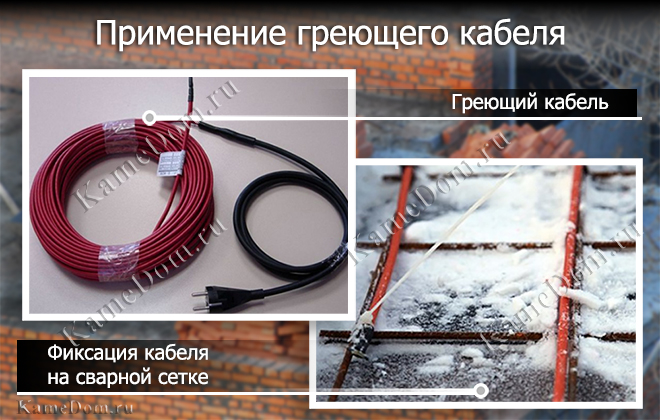
Electric heating is a rather expensive and labor-intensive method. It can be produced during the construction of small sections of walls. The process is carried out as follows: into the mortar during brick laying at negative temperatures electrodes are placed. A current is passed through them, and the seams gradually dry out without the formation of ice.
Making a greenhouse is a highly effective and economical method, but quite labor-intensive. At the site where the wall is being built, you need to make a frame and cover it with polyethylene curtains. A heater is installed inside the resulting tent and further construction can be carried out.
The freezing process is applied by using a frost-resistant solution that can set when warm weather arrives. The disadvantages of this method include the fact that you constantly need to monitor the absence of frostbite brickwork. When they appear, you must immediately use an injection burner and get rid of frost.
After a cold winter, when the first thaw occurs, you need to carefully examine the condition of the masonry and its strength. The overall strength is affected by the transverse walls inside the building. They are usually located at a distance of up to 20 m from each other. The more often they are located, the stronger the building. But it is still better to build it at positive air temperatures.
Conclusion on the topic
It is customary to build a brick structure in the warm season. A solution based on cement and sand dries well at positive temperatures and provides high strength to the entire structure. At low temperatures The drying time of the solution increases approximately 3-4 times. In cold weather it simply freezes to form ice. The volume of the solution increases by approximately 10%. When heat sets in, the ice melts and the wall shrinks greatly, significantly reducing the strength of the masonry.
When working in the cold season, you need to use special frost-resistant additives in cement mortar, electric heating, freezing, setting up hot houses. All these measures slow down the progress of construction, but significantly improve the strength of the walls being built. Potassium, sodium chloride, sodium nitrate, and potassium carbonate are added to the solution as additives. They increase the temperature of the solution to +5°C. All of them are toxic substances, so when working with them you need to use personal protective equipment.
When using electric heating, special electrodes are used, which are inserted into the seams filled with mortar. This operation is quite expensive, as it requires quite a lot of electricity.
When using the freezing method, you need to follow several rules. The solution in each section of the masonry must have the same temperature. The method can only be used at ambient temperatures down to -30°C.
But many have forgotten about the existence of one more method, which is simple and cheap: table salt added to the solution. Its only drawback is salt stains on the facade. They will have to be plastered or painted over. All of the above methods of using the mortar improve the quality and strength of a brick building.
It is considered an unacceptable construction mistake to lay bricks in cold weather. This is explained by the fact that the water in the solution cools down at low temperatures, which slows down the hardening process of the cement. If temperatures drop below zero, the water freezes and the evaporation process stops.
If someone thinks that laying bricks in cold weather will not harm the construction in any way, and that the frozen mortar can dry perfectly after the thermometer rises, he is very mistaken.
When the temperature rises above zero, the following metamorphoses occur with fresh masonry:
- uneven shrinkage of masonry;
- significant loss of structural strength.
So is it possible to lay bricks in the cold? The answer to this question is a couple of small secrets, taking into account which it will be possible to complete construction in the winter.
Features of masonry work in winter
In order to ensure the design strength of the stone or brick wall In winter, the following methods are used:
- freezing the solution;
- performing work with the addition of chemical antifreeze additives and heating the solution.
Let's look at each of these methods in more detail.
Freezing the solution
Guided by the provisions SNiP 3.03.01-87, it is possible to freeze mixtures when constructing a structure no more than 15 m high.
This could not be more relevant for country and country construction done with your own hands.
- It is prohibited to carry out construction at low temperatures for objects that will withstand significant dynamic and vibration loads (it is impossible to build in seismic zones in freezing temperatures!);
- you need to take a brand no smaller than M10;
- It is also necessary to take into account that construction must begin at positive temperatures and the walls must withstand until the seam reaches required thickness due to its compression with brick or stone to the calculated values. Start laying bricks during the day when the temperatures are positive, and if your construction site freezes at night, nothing will happen to it.
If you decide to cool the mixture in advance so as not to waste the warm part of the day cooling it, then know:
- the cold solution will form a thick layer ( correct distribution the solution can be seen in the photo);
- it will take a lot of time to apply it evenly on building brick or stone;
- The seams may turn out to be uneven, which can lead to distortion of the masonry or subsequent spalling of the mortar from a wide seam.
Advice! Start laying as soon as the thermometer shows a value above zero; the solution should be of medium heat, and steam should not be released from it. Don't put too much. A fresh wall should stand until frost. Work if the temperature is expected to drop below -20ºС is prohibited.
If you order a solution, make sure that its temperature at the time of delivery is from +5 to +15ºС. Stones or building bricks must be thoroughly cleared of snow, ice and frozen dirt at the time of construction.
When carrying out construction work, it should be taken into account that the lower the temperature, the higher the grade of the solution should be.
Using solutions with antifreeze components
When explaining the question of how to lay bricks in frost, you should remember the use of antifreeze additives to the mortar. The following additional components are used:
- urea with calcium nitrite;
- calcium chloride;
- sodium nitrite;
- sodium chloride;
- potash.
Each drug must be accompanied by instructions describing the exact proportions and technical parameters. The use of sodium and calcium chlorides contributes to an increase in the hygroscopicity of the masonry and the occurrence of efflorescence (the appearance of salt stains on the walls).
Therefore, they are usually used on the masonry of the underground part of the house. Their content in the solution should not exceed 1,5-7% from the entire mass of the mixture. The use of these additives is permitted at temperatures not lower than minus 15ºС.
Sodium nitrite is used in the construction of the above-ground part of the house. The sodium nitrite content should be 2-10% of the total mass of the solution. It is used at temperatures 0-14ºС.
Potash is included in construction mixtures in quantities 5-15% . used for thermometer readings -5-30ºС.
Advice! Do not exceed the concentration of these substances. The solution will lose its plasticity. It will be difficult to apply.
To increase the plasticity and mobility of the solution, it is prepared with the addition of sulfite-yeast mash - up to 2% of the total mass of the solution used. The addition of antifreeze components cannot but affect such an indicator as the price of the solution.
However, if construction cannot be stopped in any way, a slight increase in the cost of masonry will not be able to stop anyone. The use of anti-frost components is prohibited when constructing a room in which high humidity will be maintained.
Warming up the masonry backfill brick) or other stone, cinder block, etc., then use this method as heating the masonry.
Warm-up options:
- air heating;
- steam heating;
- electric heating
These methods must be used until the masonry has matured and the mortars have acquired the necessary strength.
- Electric heating is carried out by placing plate or rod electrodes into the seams and connecting them to the network;
- Steam heating is carried out by erecting formwork around a new area and supplying steam until the solution settles;
- Air heating is carried out using a heater and a sectional greenhouse built around the structure. Most often used when constructing a foundation.
Conclusion
After the onset of the autumn-winter period, it is not at all necessary to stop construction work. The use of these methods will allow construction to continue without slowing down. In the video provided in this article you can find additional useful information on topic
Winter time is considered not the best period for carrying out construction work. But there are situations when the conservation of a construction site can lead to significant damage. In winter, bricklaying is the most labor-intensive, but even this task is quite doable.
Brick laying in winter must be carried out taking into account certain rules, thanks to which construction work can be carried out in full even at temperatures down to -50°C.
Problems with bricklaying in winter
When laying bricks in cold weather, it is most difficult to provide the building with the required strength. When the air temperature is below zero, the water contained in the fastening solution freezes, thereby stopping the necessary process of cement hydration. If the water does not have time to turn into ice, but at the same time gets from cold areas to warm ones, this will lead to the fact that the surface of the bricks will be covered with ice. After some time, the ice located both inside the masonry and on the surface of the bricks will melt, but the adhesion of the mortar will decrease significantly. After complete thawing, the strength of the masonry will decrease by about a quarter of the required standards. In addition, when the water in the solution turns into ice and then thaws, free spaces are formed in the masonry, which can cause the structure to collapse over time.
How to prepare mortar for bricklaying
Despite the existing disadvantages, bricklaying in cold weather can be no less durable than in the warm season. However, this requires a special solution.
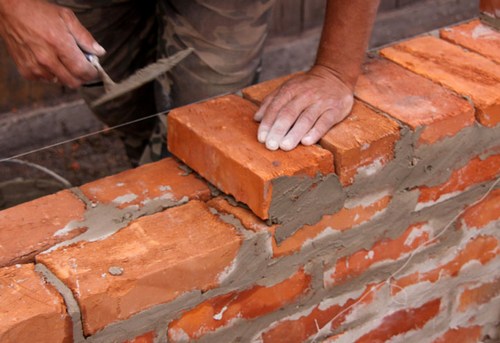
The mortar for bricklaying under conditions must include anti-frost additives that will ensure a decrease in temperature. It is recommended to use a brand of at least 50, where the necessary additives are already included. The most important thing is to monitor the solidification process of the solution. To do this, small nests with plugs are made in the masonry so that the temperature can be measured both inside and outside with a thermometer.
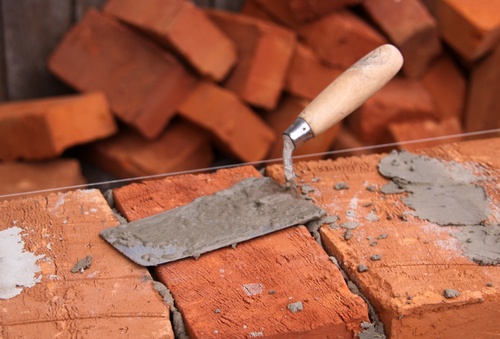
Bricklaying in winter conditions
Optimal masonry for winter can be done by artificial heating or freezing. In some cases, at very low temperatures, additional greenhouses need to be installed above the masonry itself.
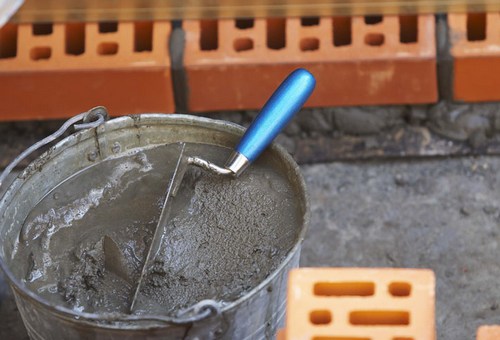
Winter mortar for bricklaying
When getting to work, you need to take into account that all antifreeze additives are poisonous to humans. You can work with them only in special clothing, safety glasses and thick gloves.
For the same reason, any mixtures that contain chemical additives are allowed to be used only for the construction of retaining walls and foundations. Laying bricks in winter conditions using chemical mixtures is strictly prohibited for the construction of residential premises.
Methods for laying bricks in winter
Masonry in sub-zero weather is most often carried out in the following ways:
- Electric heating
Since this method is quite labor-intensive and energy-consuming, it is recommended to use it only when constructing small sections of walls. During the laying of walls, electrodes are placed horizontally into the finished mortar, through which electricity will later be conducted. When heated, the electrodes will also heat the masonry seams, which, accordingly, will prevent the formation of ice. However, for effective electric heating it is extremely important that the joints are completely filled.
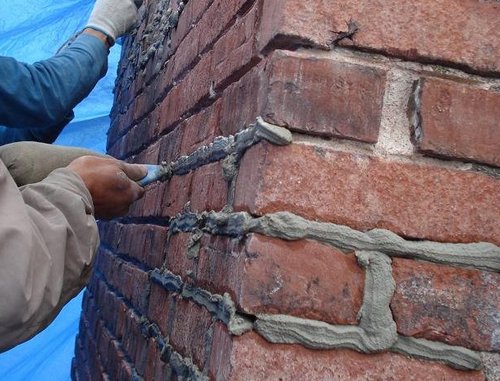
Bricklaying in sub-zero weather
- Construction of a greenhouse
This method is very effective, but quite labor-intensive. Its essence lies in the fact that a frame of slats is installed around the future wall or part of the wall. The frame is covered with plastic film or materials with similar properties. To provide heat to the future structure and the masonry mortar, any heat source must be installed inside the frame, for example, a stove, generator, electric heater, etc.
In order for winter bricklaying to be erected in accordance with all required standards, it is necessary to heat the greenhouse for several days. Since it is almost impossible to build a frame greenhouse over an entire house or even over one wall, this method is suitable exclusively for the construction of individual elements.
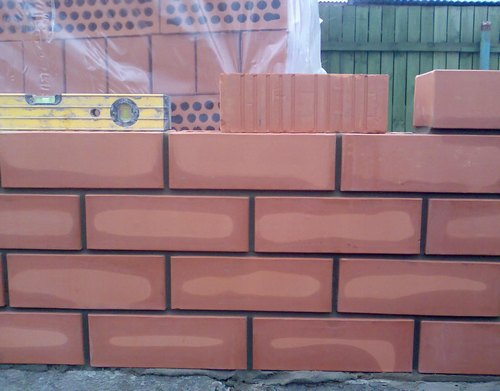
Masonry facing bricks in winter
- Freezing method
Laying facing bricks in winter is most effective if the work is carried out using the freezing method. The essence of the freezing method is based on the fact that a special cement mortar for winter bricklaying can set again some time after thawing.
For masonry using the freezing method, you can only use heated mortar and bricks that are completely free of frost. If ice has already formed on the bricks, it is more convenient to remove it using an injection burner. In addition, for this method it is recommended to use the highest grade of solution.
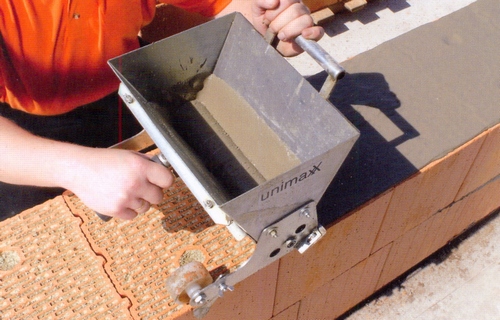
Is it possible to lay brick in winter?
The solution tends to cool quickly, which is why ice forms in it. Therefore, when heated, it must be used up in a maximum of half an hour. To avoid freezing, the solution must be diluted in small portions.
Also, the answer to the question whether it is possible to lay bricks in winter also depends on the quality of the work. During winter masonry, it is necessary to carefully monitor the filling of the seams, especially vertical ones.
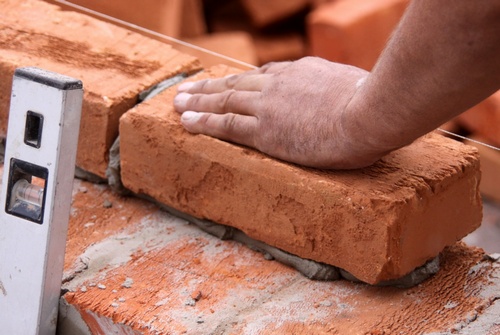
Finishing work
After erecting a brick wall to a level no higher than one floor, it is necessary to install prefabricated floors. If the masonry is carried out using the freezing method, the height of the erected structure in winter should not exceed 15 m.
In addition, it is extremely important to monitor the masonry once the thaw arrives. In order to provide additional stability and strength to the brickwork in the spring, it is necessary that the distance between it and the transverse walls does not exceed 20 m. In addition to all of the above, the walls on the south side must be covered with glassine or moistened.
 How to make honey cake according to a step-by-step recipe with photos Honey cakes in silicone molds recipes
How to make honey cake according to a step-by-step recipe with photos Honey cakes in silicone molds recipes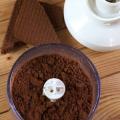 No-bake Red Velvet Cheesecake – beautiful and delicious!
No-bake Red Velvet Cheesecake – beautiful and delicious!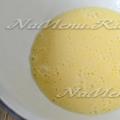 Chicken soufflé like in kindergarten
Chicken soufflé like in kindergarten